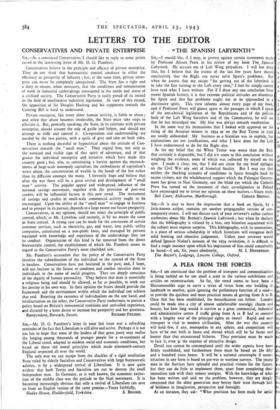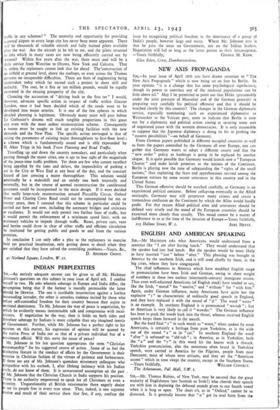A PLEA FROM THE FORCES
Sm,—I am convinced that the problem of transport and communications is being tackled on far too small a scale in the various exhibitions and articles on reconstruction. So far, the trend seems to have been a Haussmannlike urge to carve a series of vistas from one building or landmark to another, quite ignoring the preliminary function of a road— to provide the quickest and most practical means of getting from A to B. Once that has been established, the beautification can follow. London could be made into a city of almost unbelievable nostalgic charm and beauty, but how long would it survive as a great commercial, industrial and administrative centre if traffic going from A to B had to contend with a lengthy tour of the principal sights en route? Rapid and easy transport is vital to modern civilisation, After the war this country will hold few, if any, monopolies in any sphere, and competition will have to' be met both at home and abroad which will be far faster and keener than that encountered hitherto. Thus provision must be made to face it, even at the expense of attractive design.
Detail just cannot be contemplated until the wider aspects have been firmly established, and furthermore these must be based on life fifty and a hundred years hence. It will be a national catastrophe if recon- struction in any form is based on pre-war or wartime surveys. The young men in the Services have splendid and practical visions for the future, but they can do little to implement them, apart from completing their immediate task with their utmost energies. With the knowledge of what has been written and said on the problem, however, they are deeply concerned that the older generation may betray their trust through lack of boldness in imagination, perspective and foresight.
As an instance, they ask : " What provision has been made for aerial oaffic in any scheme6?" The necessity and opportunity for providing a central airport to every large city has never been more apparent. There kill be thousands of valuable aircraft and fully trained pilots available after the war. Are the aircraft to be left to rot, and the pilots returned to jobs which in many cases are now being efficiently carried out by women? Within five years after the war, there must and will be a daily service from Waterloo to Ottawa, New York and Calcutta. That is, unless the replanners cannot look that far ahead The'construction of an airfield at ground level, above the rooftops, or even across the Thames presents no insuperable difficulties. There are feats of engineering being undertaken today which far exceed such a project in sheer skill and audacity. The cost, be it five or ten million pounds, would be rapidly recovered in the ensuing prosperity of the city.
Chancing the accusation of " driving back to the first tee" I would, however, advocate specific action in respect of traffic within Greater London, once it had been decided which of the .roads were to be developed into major arteries. It is one of the few spheres in which detailed planning is legitimate. Obviously many years will pass before Le Corbusier's dreams will reach tangible proportions in this great city even with the most ardent reconstruction scheme. Consequently a means must be sought to link up existing facilities with the new demands and the New Plan. The specific action envisaged is that of raising the pavements of existing major thoroughfares to first-floor level ; a scheme which is fundamentally sound and is ably expounded by H. Alker Tripp in his book Town Planning and Road Traffic.
Travelling up and down the country nowadays, and particularly when passing through the major cities, one is apt to lose sight of the magnitude of the peace-time traffic problem. Yet there are few who cannot recollect being appalled by the jams and delays, the impossibility of parking a car in the City or West End at any hour of the day, and the constant hazard of just crossing a major thoroughfare. This solution would admittedly be a makeshift and an untidy one both internally and externally, but in the course of normal reconstruction the cantilevered pavement could he incorporated in the main design. If it were decided that really large-scale reconstruction around Piccadilly Circus, Oxford Street and Charing Cross Road could not be contemplated for ten or twenty years, then I contend that this scheme in particular could be carried out here and now, including the necessary bridges and staircases or escalators. It would not only permit two further lines of traffic, but it would permit the enforcement of a minimum speed limit, with no stationary vehicles to impede through traffic. Buses, private cars, vans and lorries could draw in clear of other traffic and efficient circulation be instituted for getting public and goods to and from the various premises.
In conclusion I can only offer a plea to the replanners to exercise bold yet practical imagination, only getting down to detail when they are satisfied that they have solved the overriding problems.—Yours, &c.,
40 Norland Square, London, W. rr. D. ADSHEAD GRANT.



























 Previous page
Previous page